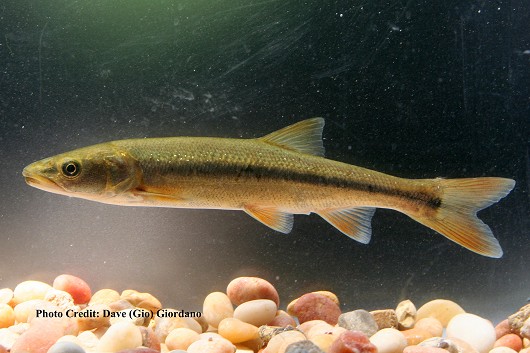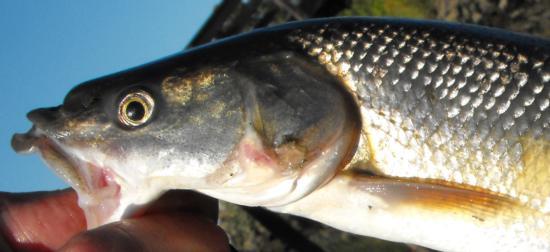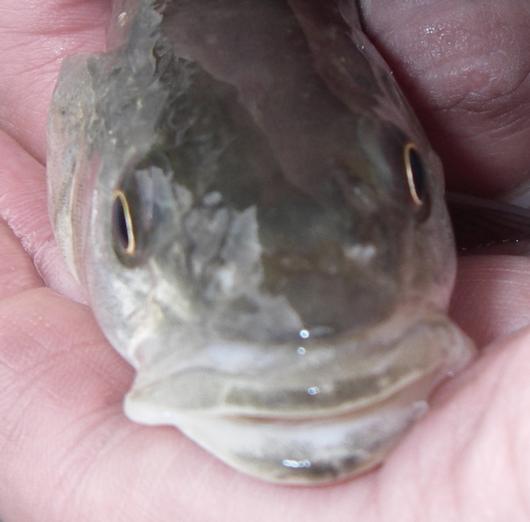Sacramento Pikeminnow
-
Scientific NamePtychocheilus grandis
-
NativeNative Species
-
Identification
 Sacramento pikeminnow, juvenile. Location: Deer Creek California (Yuba River basin). Date: 6/20/2007.
Sacramento pikeminnow, juvenile. Location: Deer Creek California (Yuba River basin). Date: 6/20/2007. Sacramento pikeminnow, adult. Photo courtesy of Dennis Cocherell, UC Davis.
Sacramento pikeminnow, adult. Photo courtesy of Dennis Cocherell, UC Davis. Sacramento pikeminnow. Location: Feather River. Date: 19 April 2010. Photo by Lisa C. Thompson. Note the size of the mouth, which is larger than that of a hardhead.
Sacramento pikeminnow. Location: Feather River. Date: 19 April 2010. Photo by Lisa C. Thompson. Note the size of the mouth, which is larger than that of a hardhead. Sacramento pikeminnow. Side view of mouth, showing lack of a frenum. Caught & released in the So. Fork Mokelumne R., 27 June 2012. Photo - Gary Riddle
Sacramento pikeminnow. Side view of mouth, showing lack of a frenum. Caught & released in the So. Fork Mokelumne R., 27 June 2012. Photo - Gary Riddle Sacramento pikeminnow, head. Location: Feather River. Date: 19 April 2010. Photo by Lisa C. Thompson. Note the lack of a frenum (bridge of skin) in the groove between the snout and upper lip.
Sacramento pikeminnow, head. Location: Feather River. Date: 19 April 2010. Photo by Lisa C. Thompson. Note the lack of a frenum (bridge of skin) in the groove between the snout and upper lip.- Big elongated fish, may exceed 1 m TL, maximum 115 cm (14.6 kg)
- Flattened head, large mouth, deeply forked tail
- Bigger adults dark brown to olive in coloration, gold-yellow underside
- Smaller fish, silver, dark spot at the base of the tail
- Spawning fish may develop orange-reddish hue on tail, males may develop nodes or breeding tubercles on head
- Fin rays: anal 8, dorsal 8, pectoral 15-18, pelvic 9
- Lateral line scales: 65-78
-
Life History
Sacramento pikeminnows, formerly known as “squawfish”, are typically found in clear low to mid-elevation streams and rivers. Pikeminnows favor streams with deep pools and slow runs that have cover in the form of undercut banks or aquatic vegetation. While pikeminnows are often found in association with native fishes in slightly disturbed streams, they are rarely found in highly polluted rivers or sharing habitat with centrarchids in lakes. They are found where water temperatures are usually in the range of 18-28°C, though they are capable of withstanding extremes up to 38°C and salinities as high as 8 ppt. Pikeminnows grow most rapidly in the first five years of life, especially in the summer months. Fish in larger warmer waters tend to grow faster and bigger than fish found in smaller cooler waters. Younger fish feed and forage during the day, while adults tend to reside in deeper pools during the day and move into riffles to feed during dawn and dusk. Juveniles may feed on aquatic insects and change the focus of their diet to crustaceans and fish as they grow bigger. Large adults are voracious opportunistic predators and may take prey anywhere at anytime. In addition to fish, prey items may include: frogs, lamprey ammocoetes, large stoneflies, and even small rodents. At age 3-4 Sacramento pikeminnows become sexually mature and begin spawning in April – May. Ideal spawning grounds are riffles and pool tails with gravel substrate. Residents of small streams might only move to a nearby riffle whereas residents of lakes and large rivers usually move up into a small tributary stream. Male pikeminnows arrive at spawning grounds before female fish when water temperatures reach a range of 15-20°C. Spawning may occur annually or less frequently when adverse conditions exist. Females measuring 31-65 cm SL produce an average of 15,000 to 40,000 eggs each. The eggs hatch in a week or less (4-7 days) under favorable conditions. Young fish gradually spread out into small schools and move into deeper water with time, often occupying protected riffles and fast water. Pikeminnows grow and develop slowly but may reach great lengths, and ages in excess of 16 years.
-
Links to Other ResearchN / A
-
Watershed
-
Alisal-Elkhorn Sloughs Watershed
-
Carmel Watershed
-
Central Coastal Watershed
-
Cottonwood Headwaters Watershed
-
Coyote Watershed
-
East Branch North Fork Feather Watershed
-
Estrella Watershed
-
Honcut Headwaters Watershed
-
Lower American Watershed
-
Lower Bear Watershed
-
Lower Butte
-
Lower Cache Watershed
-
Lower Calaveras-Mormon Slough Watershed
-
Lower Cosumnes-Lower Mokelumne Watershed
-
Lower Cottonwood Watershed
-
Lower Eel Watershed
-
Lower Feather Watershed
-
Lower Pit Watershed
-
Lower Sacramento Watershed
-
Lower Yuba Watershed
-
McCloud Watershed
-
Middle Fork Eel Watershed
-
Middle Fork Feather Watershed
-
Middle Kern-Upper Tehachapi-Grapevine Watershed
-
Middle San Joaquin-Lower Chowchilla Watershed
-
Middle San Joaquin-Lower Merced-Lower Stanislaus Watershed
-
Mill Watershed
-
Mill-Big Chico Watershed
-
North Fork American Watershed
-
North Fork Feather Watershed
-
Pajaro Watershed
-
Panoche-San Luis Reservoir Watershed
-
Russian Watershed
-
Sacramento Headwaters Watershed
-
Sacramento-Lower Cow-Lower Clear Watershed
-
Sacramento-Lower Thomes Watershed
-
Sacramento-Stone Corral Watershed
-
Sacramento-Upper Clear Watershed
-
Salinas Watershed
-
San Francisco Bay Watershed
-
San Francisco Coastal South Watershed
-
San Joaquin Delta Watershed
-
San Pablo Bay Watershed
-
South Fork American Watershed
-
South Fork Eel Watershed
-
South Fork Kern Watershed
-
Suisun Bay Watershed
-
Tulare-Buena Vista Lakes Watershed
-
Upper Bear Watershed
-
Upper Butte
-
Upper Cache Watershed
-
Upper Calaveras Watershed
-
Upper Chowchilla-Upper Fresno Watershed
-
Upper Coon-Upper Auburn Watershed
-
Upper Cosumnes Watershed
-
Upper Cow-Battle Watershed
-
Upper Deer-Upper White Watershed
-
Upper Dry Watershed
-
Upper Eel Watershed
-
Upper Elder-Upper Thomes Watershed
-
Upper Kaweah Watershed
-
Upper Kern Watershed
-
Upper King Watershed
-
Upper Los Gatos-Avenal Watershed
-
Upper Merced Watershed
-
Upper Mokelumne Watershed
-
Upper Pit Watershed
-
Upper Poso Watershed
-
Upper Putah Watershed
-
Upper San Joaquin Watershed
-
Upper Stanislaus Watershed
-
Upper Stony Watershed
-
Upper Tule Watershed
-
Upper Tuolumne Watershed
-
Upper Yuba Watershed
-
Please note, watersheds are at the USGS 8-digit Hydrologic Unit Code (HUC) scale, so they often include a lot of sub-watersheds. If a species occurs in any sub-watershed within the HUC, the species appears within the HUC. Link to an EPA page that shows HUCs.




